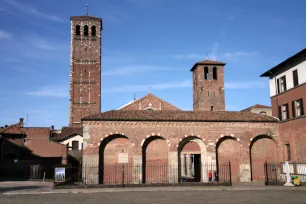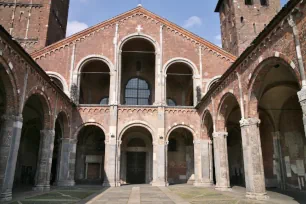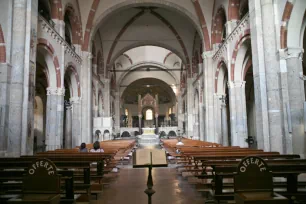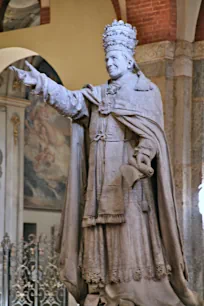The Basilica of Sant’Ambrogio is one of Milan’s oldest and most important churches. It is named after the city’s patron saint, Saint Ambrosius (Ambrose), who consecrated the church in 386 AD during his tenure as bishop of Milan.
History


The church was originally named after the saints Gervasius and Protasius (aka Gervase and Protase), whose remains were found at the site. After Ambrose died in 397, the church was dedicated to him instead.
At the end of the eighth century, the Benedictines built a convent next to the church. Two centuries later the church had become too small, and during the following centuries most of the structure was rebuilt and expanded. In 1492 Donate Bramante started with the construction of the cloisters and a portico, but work was halted when his patron Ludovico Il Moro was ousted from Milan. After it was damaged during bombardments in 1943, Bramante’s work was restored and in 1955 it was finally completed by Ferdinando Reggiori.
Atrium
The Church of Sant’Ambrogio is built well below present day’s street level and seems tucked away behind the Anspert atrium, which as an entrance courtyard to the church. The atrium was built in the eleventh century, when it replaced an older, ninth century atrium commissioned by archbishop Anspert as a shelter for pilgrims.
Two towers are visible from the atrium. The tallest one on the left is known as the Campanile dei Canonici and was built in the eleventh century. The smaller tower to the right is the Campanile dei Monaci, built by the Benedictines in the eighth century. The porticoes around the atrium were mostly rebuilt after the Second World War. The most interesting is the portico at the narthex, which is decorated with animal motifs and surmounted by a loggia with five arches.
Interior

The church has a solemn and soberly decorated interior. A central cross vaulted nave, typical for Lombardian architecture, is flanked on either side by aisles. Above the aisles are the women’s galleries.
The gold altar was created in the ninth century by Volvinio to hold the remains of Saint Ambrose. It is magnificently decorated with reliefs depicting scenes from the saint and Christ. The baldachin above the altar, also decorated with reliefs, dates from the tenth century and rests upon four porphyry columns, possibly from the original fourth century church.

The apse is decorated with mosaics that predate the reconstruction of the eleventh century. They were however damaged during the Second World War and are now restored.
The original pulpit was destroyed in 1198, when part of the roof collapsed. It was probably recreated in the thirteenth century with pieces from the original. Below the pulpit is one of the highlights in the church: the fourth century Stilicho sarcophagus. It is named after the Roman military commander Stilicho, but possibly contains the remains of emperor Flavius Gratianus instead.
The most notable chapel in the church is the chapel of San Vittore in Ciel d’Oro. The chapel was built in the fourth century as a separate structure to hold the remains of Saint Victor, a local martyr who died in 303. The ceiling of the chapel is decorated with fifth century mosaics depicting the saints Ambrose, Gervase and Protase.
- Next: Pirelli Tower
- More Sights & Attractions in Milan

